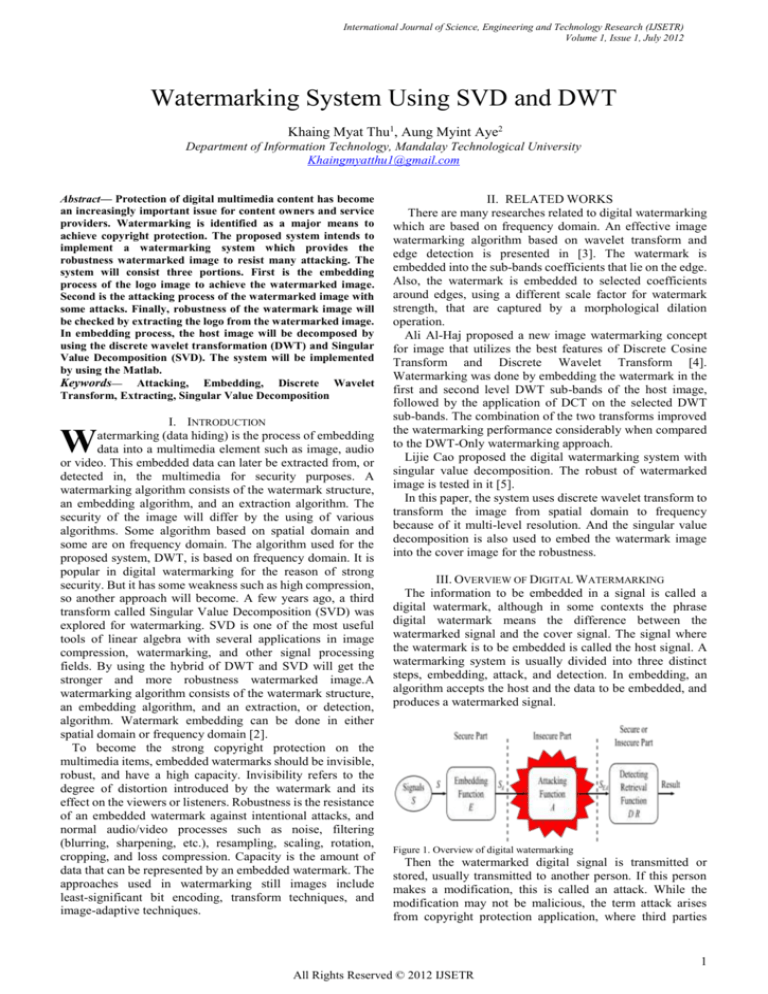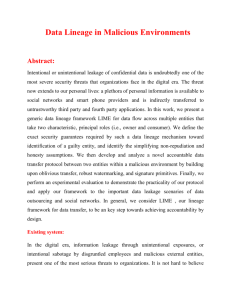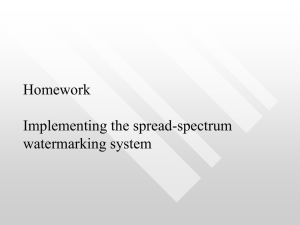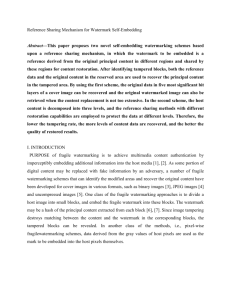
International Journal of Science, Engineering and Technology Research (IJSETR)
Volume 1, Issue 1, July 2012
Watermarking System Using SVD and DWT
Khaing Myat Thu1, Aung Myint Aye2
Department of Information Technology, Mandalay Technological University
Khaingmyatthu1@gmail.com
Abstract— Protection of digital multimedia content has become
an increasingly important issue for content owners and service
providers. Watermarking is identified as a major means to
achieve copyright protection. The proposed system intends to
implement a watermarking system which provides the
robustness watermarked image to resist many attacking. The
system will consist three portions. First is the embedding
process of the logo image to achieve the watermarked image.
Second is the attacking process of the watermarked image with
some attacks. Finally, robustness of the watermark image will
be checked by extracting the logo from the watermarked image.
In embedding process, the host image will be decomposed by
using the discrete wavelet transformation (DWT) and Singular
Value Decomposition (SVD). The system will be implemented
by using the Matlab.
Keywords— Attacking, Embedding, Discrete Wavelet
Transform, Extracting, Singular Value Decomposition
I. INTRODUCTION
atermarking (data hiding) is the process of embedding
data into a multimedia element such as image, audio
or video. This embedded data can later be extracted from, or
detected in, the multimedia for security purposes. A
watermarking algorithm consists of the watermark structure,
an embedding algorithm, and an extraction algorithm. The
security of the image will differ by the using of various
algorithms. Some algorithm based on spatial domain and
some are on frequency domain. The algorithm used for the
proposed system, DWT, is based on frequency domain. It is
popular in digital watermarking for the reason of strong
security. But it has some weakness such as high compression,
so another approach will become. A few years ago, a third
transform called Singular Value Decomposition (SVD) was
explored for watermarking. SVD is one of the most useful
tools of linear algebra with several applications in image
compression, watermarking, and other signal processing
fields. By using the hybrid of DWT and SVD will get the
stronger and more robustness watermarked image.A
watermarking algorithm consists of the watermark structure,
an embedding algorithm, and an extraction, or detection,
algorithm. Watermark embedding can be done in either
spatial domain or frequency domain [2].
To become the strong copyright protection on the
multimedia items, embedded watermarks should be invisible,
robust, and have a high capacity. Invisibility refers to the
degree of distortion introduced by the watermark and its
effect on the viewers or listeners. Robustness is the resistance
of an embedded watermark against intentional attacks, and
normal audio/video processes such as noise, filtering
(blurring, sharpening, etc.), resampling, scaling, rotation,
cropping, and loss compression. Capacity is the amount of
data that can be represented by an embedded watermark. The
approaches used in watermarking still images include
least-significant bit encoding, transform techniques, and
image-adaptive techniques.
W
II. RELATED WORKS
There are many researches related to digital watermarking
which are based on frequency domain. An effective image
watermarking algorithm based on wavelet transform and
edge detection is presented in [3]. The watermark is
embedded into the sub-bands coefficients that lie on the edge.
Also, the watermark is embedded to selected coefficients
around edges, using a different scale factor for watermark
strength, that are captured by a morphological dilation
operation.
Ali Al-Haj proposed a new image watermarking concept
for image that utilizes the best features of Discrete Cosine
Transform and Discrete Wavelet Transform [4].
Watermarking was done by embedding the watermark in the
first and second level DWT sub-bands of the host image,
followed by the application of DCT on the selected DWT
sub-bands. The combination of the two transforms improved
the watermarking performance considerably when compared
to the DWT-Only watermarking approach.
Lijie Cao proposed the digital watermarking system with
singular value decomposition. The robust of watermarked
image is tested in it [5].
In this paper, the system uses discrete wavelet transform to
transform the image from spatial domain to frequency
because of it multi-level resolution. And the singular value
decomposition is also used to embed the watermark image
into the cover image for the robustness.
III. OVERVIEW OF DIGITAL WATERMARKING
The information to be embedded in a signal is called a
digital watermark, although in some contexts the phrase
digital watermark means the difference between the
watermarked signal and the cover signal. The signal where
the watermark is to be embedded is called the host signal. A
watermarking system is usually divided into three distinct
steps, embedding, attack, and detection. In embedding, an
algorithm accepts the host and the data to be embedded, and
produces a watermarked signal.
Figure 1. Overview of digital watermarking
Then the watermarked digital signal is transmitted or
stored, usually transmitted to another person. If this person
makes a modification, this is called an attack. While the
modification may not be malicious, the term attack arises
from copyright protection application, where third parties
1
All Rights Reserved © 2012 IJSETR
International Journal of Science, Engineering and Technology Research (IJSETR)
Volume 1, Issue 1, July 2012
may attempt to remove the digital watermark through
modification. There are many possible modifications, for
example, lossy compression of the data (in which resolution
is diminished), cropping an image or video, or intentionally
adding noise [6].
Detection (often called extraction) is an algorithm which is
applied to the attacked signal to attempt to extract the
watermark from it. If the signal was unmodified during
transmission, then the watermark still is present and it may be
extracted.
In robust digital watermarking applications, the extraction
algorithm should be able to produce the watermark correctly,
even if the modifications were strong. In fragile digital
watermarking, the extraction algorithm should fail if any
change is made to the signal.
Watermarking schemes can be divided into two main
categories according to the embedding domain: spatial
domain and transform domain schemes. In spatial domain,
the watermark is embedded into the specific pixels of the
cover image.
In transform domain, the cover image is first transformed
to a frequency domain and then watermark is embedded into
the frequency coefficients. Although the transform domain
watermarking scheme is more complex than spatial domain
watermarking, this kind of watermarking is more robust
against different attacks than spatial domain watermarking.
IV. TRANSFORM DOMAIN
Transform domain embeds a watermark by modifying the
transform coefficients of the cover image as opposed to the
pixel values. Ideally, transform domain has the effect in the
spatial domain of apportioning the hidden information
through different order bits in a manner that is robust.
There are a number of transforms that can be applied to
digital images, but there are notably three most commonly
used in image watermarking. They are Discrete Fourier
Transform (DFT), Discrete Cosine Transform (DCT) and
Discrete Wavelet Transform (DWT). In the recent day,
another transform method, singular value decomposition
(SVD) also becomes popular for its robustness. In the
proposed system, the DWT and SVD are used for the digital
watermarking algorithms.
A. Discrete Wavelet Transform (DWT)
Wavelet domain is a promising domain for watermark
embedding. Wavelet refers to small waves. Discrete Wavelet
Transform is based on small waves of limited duration and
varying frequency [7].
This is a frequency domain technique in which firstly cover
image is transformed into frequency domain and then its
frequency coefficients are modified in accordance with the
transformed coefficients of the watermark and watermarked
image is obtained which is very much robust.
DWT decomposes image hierarchically, providing both
spatial and frequency description of the image [8]. It
decompose an image in basically three spatial directions i.e,
horizontal, vertical and diagonal in result separating the
image into four different components namely LL, LH, HL
and HH. The decomposing step of the DWT is shown in Fig
2.
Here first letter, Lo or HI, refers to applying either low pass
frequency operation or high pass frequency operations to the
rows and the second letter, D, refers to the filter applied to the
columns of the cover image [9].
Figure 2. Decomposing Step of DWT
In general most of the image energy is concentrated at the
lower frequency sub-bands LL and therefore embedding
watermarks in these sub-bands may degrade the image
significantly. Embedding in the low frequency sub-bands,
however, could increase robustness significantly. On the
other hand, the high frequency sub-bands HH include the
edges and textures of the image and the human eye is not
generally sensitive to changes in such sub-bands. This allows
the watermark to be embedded without being perceived by
the human eye. The proposed system use LH and HL
sub-bands of cover image to embed the watermark image.
By using DWT, the image can be decomposed many times
to get the multi-resolution image as shown in Fig 3.
Figure 3. Multi-Level Resolution
1st Level
Decompose
LL1
HL1
LH1
HH1
Original
Image
2nd Level
Decompose
LL2 HL2
LH2 HH2
LH1
HL1
HH1
DWT can reconstruct again to obtain the image from the
multi-resolution sub-bands. This is known as inverse discrete
wavelet transform (IDWT). The process of IDWT is shown
in Fig 4.
Figure 4. Reconstruction Step of DWT
There are so many wavelets to use in DWT which are such
as Harr wavelets, Daubechie wavelets and so on. The
proposed system used Daubechie-5 wavelets for sampling of
DWT.
B. Singular Value Decomposition (SVD)
Singular Value Decomposition transform is a linear
algebra transform which is used for factorization of a real or
complex matrix with numerous applications in various
fields of image processing [10]. As a digital image can be
represented in a matrix form with its entries giving the
2
All Rights Reserved © 2012 IJSETR
International Journal of Science, Engineering and Technology Research (IJSETR)
Volume 1, Issue 1, July 2012
intensity value of each pixel in the image, SVD of an image A
with dimensions m x m is given by:
A = USVT
Key
H
Watermark
where U and V are orthogonal matrices and S known as
singular matrix is a diagonal matrix carrying non-negative
singular values of matrix A.
The columns of U and V are called left and right singular
vectors of A, respectively. They basically specify the
geometry details of the original image. Left singular matrix
i.e., U represents the horizontal details and right singular
matrix i.e., V represents the vertical details of the original
image.
The diagonal values of matrix S are arranged in decreasing
order which signifies that importance of the entries is
decreasing from first singular value for the last one, and this
feature is employed in SVD based compression techniques.
Figure 5. From an image’s matrix to S, V and U matrices
The
Embedding
Process
Watermarked
Cover
Unintentional
Distortions
Possibly
Distorted
Watermarked
Cover
Intentional
Attacks
Cover
Distorted Mark
or Confidence
Meassure
The Detection
Process
Key Inserted
Watermark
H
Yes
Valid
Watermark
No
Invalid Key
Key
Figure 7. Ovzerall system design of proposed system
A. Embedding Algorithm
The following procedure describes the algorithm of
embedding process in step by step.
1. Load a cover image
2. Transform cover image from spatial domain to
transform domain by using DWT (LL, LH, HL and HH)
3. Apply SVD to LH and HL sub-bands of the cover
image (S1,V1,U1 and S2,V2,U2)
4. Both S1 and S2 are sum with factor* encrypted
watermark image to get the new values of
matrix.(temp1key and temp2key) temp1key= S1+(f*Wen)
5. Apply SVD to temp1key to get the S1key, V1key and U1key
matrices of the watermark
6. The new value of LHnew is computed from U1, VT and
S1key. And the new value of HLnew is also computed like
this.
7. The watermarked cover image can reconstructed form
the LL,LHnew,HLnew and HH by using IDWT.
B. Attacking State
In the attacking state, there can be a wide-ranging of attacks
has been designated in the literature [8]. In the real world,
four types of attacks can be invoked to enter a watermarking
Figure 6. From S, VT and U matrices to image matrix
system:
Removal
attacks,
Geometrical
attacks,
There are two main properties of SVD to employ in digital Cryptographic attacks and Protocol attacks. The attack is
watermarking schemes [8]:
positive if the watermarking can’t be finding anymore, but
1. Small variations in singular values does not affect the the image is still understandable and can be used for specific
quality of image and,
determined purpose. And many such
2. Singular values of an image have high stability so; they
attack actions have proposed lossy image compression, addition of
do not change after various attacks.
gaussian noise, denoising filtering, median filtering and
blurring, signal enhancement and rotating and cropping.
V. PROPOSED SYSTEM DESIGN
The proposed system used the DWT and SVD to embed C. Detection or Extraction Algorithm
The algorithm for the detection process is listed in the
and extract of the digital watermark into the cover image in
order to get robust watermarked image. The robust image can following procedure.
gain strong protection to the owner ship or copy right of the
1. The possibly distorted watermarked image is
original cover image.
decomposed into four sub-bands by using DWT
The proposed system includes three portions which are
algorithm. (LL, LH, HL and HH)
embedding, distortion or attacking and detection or
2. Applied SVD to LH and HL sub-bands (which already
extraction. The proposed system is to ensure the copy right
contain the encrypted watermark image) (S1new, U1new,
protection of the original image. The overall system design of
V1new)
the proposed system is shown in Fig 7.
3. Input the required data set (DS) for semi-blind
Before the embedding process, the user needs to enter the
extraction.
key to combine with the watermark image. The watermark
4. Compute the new LH and HL from DSu, DSvT and
image will be combined with the hashed key. And that
S1new.
resulted watermark image will be embedded into the cover
5. Subtract DSs From S1new and divide by factor to obtain
image as a signature of the copyright protection.
the encrypted watermark image of LH and HL. ( W
en
=S1new – S /factor)
3
All Rights Reserved © 2012 IJSETR
International Journal of Science, Engineering and Technology Research (IJSETR)
Volume 1, Issue 1, July 2012
6. If the user inserted key is correct, the inserted
watermark will be extracted or detected.
VI. TEST AND RESULT
The following results are generated by implementing the
proposed system. In this paper, the results are displayed a
series of interface. The standard Lena image is used as the
host or cover image in the testing. And another logo image is
used as watermark image. Those images are show in Fig 8
and Fig 9.
Figure11. The 4 sub-bands of the cover image
Figure 8. Standard Lena as host image
Among these 4 sub-bands, the LH and HL sub-bands will
be used to embed the watermark. LH and HL sub-bands are
applied with SVD decomposition to get the S, V and U
matrices of the images.
And S matrix or diagonal matrix will be replaced with a
new diagonal which are computed from the S matrix and the
key inserted watermark image.
And then, the new value of LH and HL are calculated from
Snew* U*VT. After that, the watermarked image will
computed from the LL, LHnew, HLnew, HH. The result
watermarked image is shown in the Fig 12.
And then, the resulted watermarked is attacked with some
attacking or distortion methods. The resulted intentional
attacked images are shown in Fig13 to Fig 15.
Figure 9. Logo image as watermark image
Firstly, the user has to enter the key to the watermark
image. After hashing the key, the watermark image is
combined with that key and will be displayed the resulted
watermark image. The original watermark and key inserted
watermark images are show in Fig 10.
Figure 12. Key inserted watermark embedded in the cover image
Hash
Figure 10. Original watermark and key inserted watermark
To embed the key inserted watermark image, the cover
image need transform into transform domain. So, the cover
image is decomposed into 4 sub-bands which are LL, LH, HL
and HH by using DWT embedding algorithm. The resulting
sub-bands are show in Fig 11.
Figure 13. Cutting and Brightening
4
All Rights Reserved © 2012 IJSETR
International Journal of Science, Engineering and Technology Research (IJSETR)
Volume 1, Issue 1, July 2012
Figure18. The watermark with higher correlation coefficient
Figure 14. 45 degree rotation and Gaussian noise attack
Figure 15. Increasing contract and histogram equalization
The next step is the detection or extraction process of
watermark. After attacking the cover watermarked image, the
image may alter on geological pixel values. The possibly
distorted watermarked image are decomposed into four
sub-bands (LL, LH,HL and HH) to extract the key inserted
watermark. And then, the LH and HL are applied with SVD
and the key inserted watermark’s diagonal matrix will be
computed. The user needs to enter the key to get the
watermark from the key inserted watermark. If the key is
correct, the resulted watermark will be shown. The key
inserted watermark and the extracted watermark are shown in
Fig 16, 17 and 18.
VII. CONCLUSION
In the proposed system, it implements the digital
watermarking with DWT and SVD for improving robust and
safe from many geometrical attacks. The system use DWT-2
(Daubechie-5 wavelet) for decomposing the cover image. In
this proposed system, one dimension of SVD is used singular
decomposing. This proposed system can be seen as semi
blind watermarking system which has to use again the
original watermark in the extraction process. And future
work can be with another higher level of DWT and other
dimension like 2D and 3D of SVD can be used for better
copyright protection. Moreover, the blind watermarking
system can also be contributed to this proposed system to
achieve more powerful watermarking system.
VIII. REFERENCES
Wikipedia,“Digital Watermarking”, http://en.wikipedia.org/wiki/
Digital _watermarking, 2011.
[2] Richa Mishra, “Watermarking Techniques via Discrete Wavelet
Transform”, 2013.
[3] John N. Ellinas, “A Robust Wavelet-Based Watermarking Algorithm
Using Edge Detection”, World Academy of Science, Engineering and
Technology, 2007.
[4] Ali Al-Haj,“Combined DWT-DCT Digital Image Watermarking”,
Journal of Computer Science, 2007.
[5] Lijie Cao, “Singular Value Decomposition Applied To Digital Image
Processing”, 2011.
[6] Harish N J, “Hybrid Robust Watermarking Technique Based on DWT,
DCT”, 2013.
[7] Chunlin Song, SudSudirman, MadjidMerabti, “Recent Advances and
Classification of Watermarking Techniques in Digital Images”, ISBN:
978-1-902560-22-9, 2009.
[8] Vaishali S. Jabade,Dr. Sachin R. Gengaje, “ Literature Review of
Wavelet Based Digital Image Watermarking Techniques”,
International Journal of Computer Applications, October 2011.
[9] M. MohamedSathik, S. S. Sujatha, “A Novel DWT Based Invisible
Watermarking Technique for Digital Images”, International Arab
Journal of e-Technology, January 2012.
[10] R. Liu and T. Tan, “An SVD-based watermarking scheme for
protecting rightful ownership,” IEEE Transactions on Multimedia,
Mar 2002.
[1]
Figure16. The extracted watermark
Figure17. The extracted watermark images from LH and
HL
5
All Rights Reserved © 2012 IJSETR







